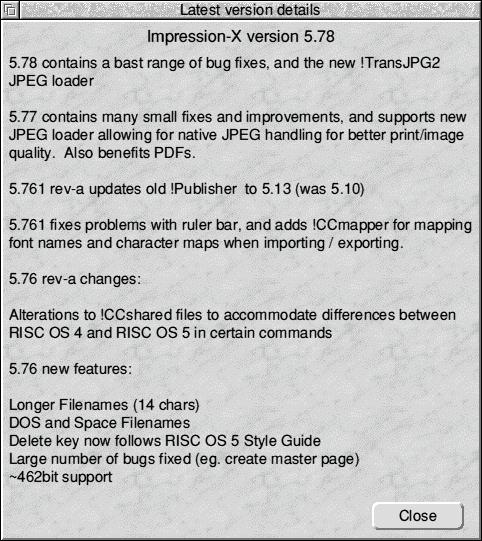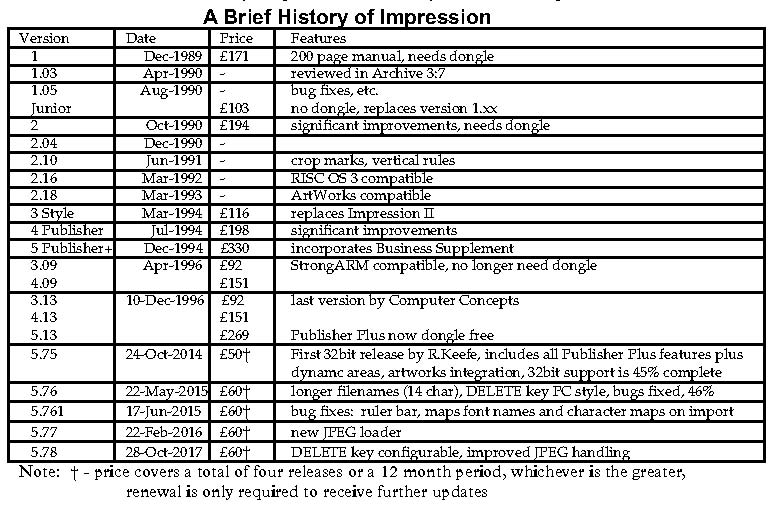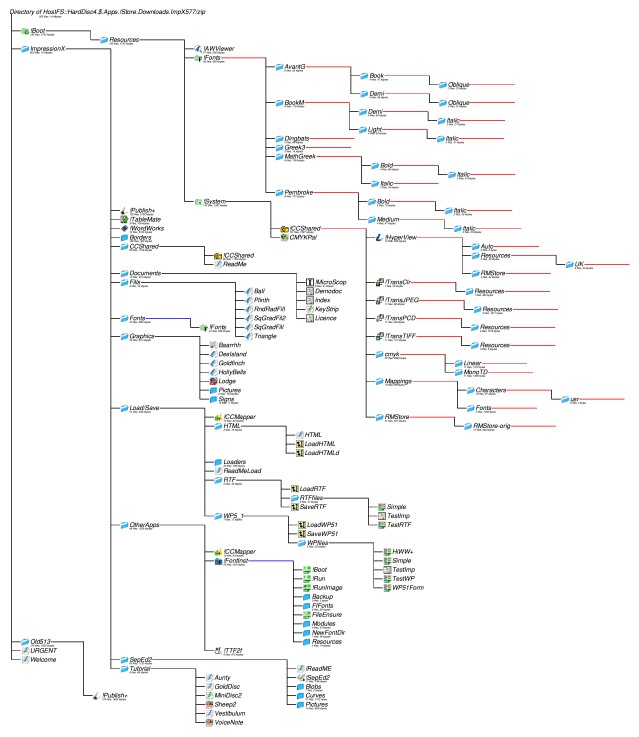Impression-X
Impression-X
Impression-X is now at version 5.78 and is available from !Store. Version 5.799 (06-Mar-2020) is being rolled out to subscribers this weekend (14 March) and will also be available from !Store in due course.
A regular newsletter is available
Impression-X version 5.75 was released by Richard Keefe at the London show in 2014 (as reported in Archive magazine 23:10). It was supplied on a USB stick complete with all components. Since then it has also been possible to download updates from !Store, the latest of which is currently version 5.78 released on 28 October 2017. Four updates (or a year’s subscription) cost you £60 (there was an initial offer of £50) whether from Richard direct or from !Store. Although described as a subscription you can continue to use the software when your subscription ends but to continue receiving updates you would need to renew.
!Store describes the changes in the versions up to 5.77 as shown in the box to the right and provides the components neatly arranged ready to be copied to your hard disc (a directory display of the contents of the download zip is shown to the right). This is very good news for new users as it makes installation very simple.
At the London show in October 2017 an incremental update to ‘update 4b’ - version 5.78 - was available which included an option in 'Choices' to specify the behaviour of the DELETE key as either ‘as Style Guide’ or ‘as Backspace’. Another 36 of the 800 bugs that had been fixed in 5.13 have been applied. Images can now be manually scaled to a minimum of 1% vice 5% - important now that digital images are so big. There are new options, not yet fully implemented, on the Printer Setup screen. The build method can now produce Impression-X or a 5.13 equivalent and the licensing structure has been changed so that in the next build a single build image will be suitable for everyone (rather than needing a bespoke one). An updated version of !TransJPEG (called !TransJPG2) is supplied which improves the handling of JPEG files as you drag them onto an Impression window. These updates should be sent out to subscribers over the next few weeks.

The details of the latest version, as shown on !Store.
History of Impression
A pre-release version of Impression was made available in September 1989, with a few features not fully implemented and the manual only half complete. By December 1989 it was being advertised at £171 complete with a 200 page manual and able to work on a 1Mbyte machine leaving over 300k free! It would be provided with a ‘dongle’ as hardware copy protection for the next seven years. Copy protection is important whilst development costs are still being recovered.
At this time the A410/1 (upgraded from 1 to 4 Mbytes RAM and 40Mbyte HDD) was available for £2140, whereas a ‘base’ A310 could be had for as little as £600.
Version 1.03 was reviewed in Archive 3:7 (April 1990) and was described as well designed and thought out. Version 1.05 became Impression Junior (with no dongle) and Impression II was released in October 1990 at £194.
At this time the new A540 was just being released at £3440 and several hundred had been ordered by dealers but only 20 had been produced.
The principal differences between Impression Junior and Impression II were described in Archive 4:2 (November 1990):
- no master pages (new pages copy previous page design);
- no styles menu, just effects;
- no indexing facility;
- limited colour control.
Impression Junior (with no dongle but more capable than Impression I) thus competed directly with Ovation (which did still have protection until April 1992). Because Impression could run on a 1Mbyte machine it was able to build up large user base. A ‘Business Supplement’ was available in June 1991 for £57.
By January 1994 Impression Publisher was being announced (£198) and by March 1994 Impression Style (£116) was on sale, Publisher following it from July 1994. Impression Style had facilities similar to Impression II and thus superseded it. The Style, Publisher and Publisher Plus version numbers were now in the 3.xx, 4.xx and 5.xx series respectively.
Acorn announced the new Risc PC in May 1994 and by September 1995 the Risc PC 700 was on sale at £1989 with an ARM710, 850MB HDD and 10MB RAM - the price dropped to £1135 by March 1997.
By December 1994 there were over 30,000 users of Impression and Impression Publisher Plus had been added to the range. Complaints about the dongle were growing by March 1995.
In September 1996 the StrongARM processor was released (the processor is on a plug-in board in the Risc PC) and StrongARM-compatible versions of Impression were released - from this point onwards no ‘dongle’ was required.
Version 5.13 (10-Dec-1996) was the last version released by Computer Concepts. Many users persevered with this version for the next eighteen years, using it on modern hardware, Iyonix, Beagleboard, Pandaboard, Raspberry Pi, ARMX6, IGEPv5 and Titanium under Aemulor so that it could run on 32 bit systems.
Conversion to 32 bit-safe started in 2003 by X-Ample Technology and the forthcoming product was named Impression-X. Conversion proved difficult but was eventually taken over by Richard Keefe and in 2014 the next update was released.
What are the implications?
We now have a mature application, Impression-X, that was heavily developed from 1989 to 1996, that then languished for eighteen years but is now being developed again.
In the period from 1996 to 2014, Acorn broke up (1998), RISC OS was developed from 3.60 to 4.02, 4.39, Six and now 5.23. Some recently added features, such as JPEGs embedded in Draw files, have not yet made it into Impression-X but then some Draw features present in 1989 (text area objects embedded in Draw files) have not yet made it into ArtWorks.
A major change in 1994 was the Risc PC but machines with large amounts of RAM were rare and it was only late in 1996 that Impression could correctly handle documents larger than 20MB on machines with large amounts of RAM. Under Aemulor, the maximum Wimpslot is 28MB but version 5.75 included all the features of Publisher Plus as well as dynamic areas for very large documents, 32-bit aware, ArtWorks integration and 45% of the application was now native 32 bit.
Version 5.76 added longer (14 character) filenames and version 5.78 now handles JPEGs, previously they had to imported via ArtWorks.
What is it?
Impression-X is a powerful word processor and a fully-featured, extremely fast, DTP package - a comprehensive document processor. A 330 page manual was produced for Impression Publisher.
It is based on frames - a master page for each ‘chapter’ shows the default frames, which may contain either text or a graphic, and local frames may be added to individual pages. Text flows from one page to the next and ‘wraps around’ any graphic.
Text may contain styles and can be saved as a ‘story’ with the various style definitions embedded so that a story can be dropped into any empty or text frame and all the styling and effects will be included. Style definitions can be applied to one or more paragraphs or parts of paragraphs and the styles in use on any part of the document can be viewed on the style menu. It is truly WYSIWYG and uses the Acorn outline fonts.
Using tables of text is rather tricky as you have to set up ‘rule-off’ lines and vertical bars as part of a paragraph style but tab stops allow movement from column to column and can be ‘left’, ‘decimal’, ‘centered’ or ‘right’. However TableMate, available from CJE Micros in an updated form, version 5.03d (04 Nov 2001), makes this process much easier.
One advantage of using styles is that the whole document will be reformatted if you edit a named style that is used in the document. Style definitions are saved as part of the document.
Printing to a Postscript 3 printer driver allows PDFs to be created which are very economical on memory usage.
Conclusion
Impression is a killer application for RISC OS and I can thoroughly recommend purchasing it for the excellent price of £60. It will still require Aemulor but that is available for current hardware (for both low vector and high vector ROMs) as a free download.
I would recommend new users to obtain Impression-X via !Store as that offers the most well explained and presented installation instructions. The price of £60 now looks expensive against the cost of the cheapest hardware whereas its original cost of over £100 looked cheap when hardware costs were over £1000. I can, though, thoroughly recommend it as good value for money.
Four of the five feature updates scheduled for the next three releases when Impression-X was launched have now been included, leaving only ‘JPEG support for JPEGs embedded in Draw files’ yet to be completed. The software is therefore being actively developed and the developer is listening to feedback from users.
On the negative side there is not yet any web site promoting Impression-X and extolling its virtues.
Users who signed up in October 2014 will need to renew their subscription to receive version 5.78 whilst new users only need to start subscribing now.
Archive magazine is produced using Impression, so that just shows what can be done with this application. I find it extremely useful and intuitive. Importing text with styles allows a frame within an Impression document to be created programmatically.

